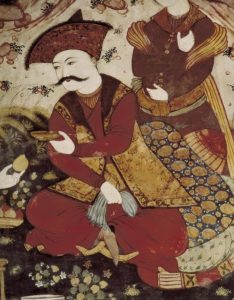During the reign of Shah Abbas, the great (1587-1629), the Persian court’s greatest miniature artists amused themselves by creating luxurious and elaborate designs to transfer to carpets; aside from devoting themselves to new decorative inventions, they turned in some cases to the transformation and stylistic adaption of motifs that were already known and consolidated by the general artistic tradition.
 Among these was the palmette, an ancient floral motif inspired by the fan-shaped leaves of the palm or the lily. When the palmette first appeared in carpets at the beginning of the 16th century it’s from was still somewhat rigid, but by the end of that century it had become lusher, so much so that it was transformed into the leading floral element in carpet decoration. The artist of the court of Shah Abbas elaborated the palmette into richer and more naturalistic forms, creating palmettes still slightly closed, as though budding, and therefore of elongated form, and “flaming” palmettes, by which was meant those already flowering, with open corollas fringed with numerous petals spread in a sunburst. These new floral elements, designed in honor of the sovereign, were baptized Shah Abbas palmettes. In the decoration of carpets, they are used joined by curvilinear vines and ornamented with falciform leaves. The new composition enjoyed great success in all Persian carpets, even during later centuries, and its basic design came to be called the Shah Abbas design.
Among these was the palmette, an ancient floral motif inspired by the fan-shaped leaves of the palm or the lily. When the palmette first appeared in carpets at the beginning of the 16th century it’s from was still somewhat rigid, but by the end of that century it had become lusher, so much so that it was transformed into the leading floral element in carpet decoration. The artist of the court of Shah Abbas elaborated the palmette into richer and more naturalistic forms, creating palmettes still slightly closed, as though budding, and therefore of elongated form, and “flaming” palmettes, by which was meant those already flowering, with open corollas fringed with numerous petals spread in a sunburst. These new floral elements, designed in honor of the sovereign, were baptized Shah Abbas palmettes. In the decoration of carpets, they are used joined by curvilinear vines and ornamented with falciform leaves. The new composition enjoyed great success in all Persian carpets, even during later centuries, and its basic design came to be called the Shah Abbas design.
(The Bulfinch Guide to Carpets)
